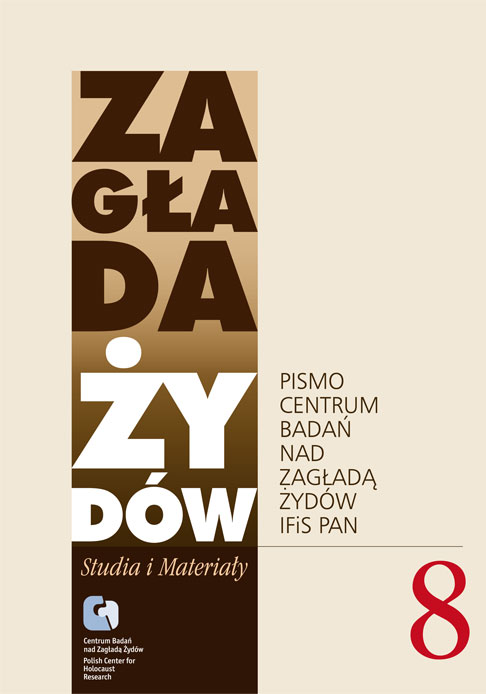O tym, co minęło, lecz nie zostało zapomniane: Badania archeologiczne na terenie byłego obozu zagłady w Treblince
Zagłada Żydów. Studia i Materiały, Nr 8 (2012), Strony: 83-118
Data zgłoszenia: 2020-10-27Data publikacji: 2012-12-02
 https://doi.org/10.32927/ZZSiM.628
https://doi.org/10.32927/ZZSiM.628
Abstrakt
Public impression of the Holocaust is unquestionably centred on knowledge about, and the image of, Auschwitz-Birkenau – the gas chambers, the crematoria, the systematic and industrialized killing of victims. Conversely, knowledge of the former extermination camp at Treblinka, which stands in stark contrast in terms of the visible evidence that survives pertaining to it, is less embedded in general public consciousness. As this paper argues, the contrasting level of knowledge about Auschwitz- Birkenau and Treblinka is centred upon the belief that physical evidence of the camps only survives when it is visible and above-ground. The perception of Treblinka as having been “destroyed” by the Nazis, and the belief that the bodies of all of the victims were cremated without trace, has resulted in a lack of investigation aimed at answering questions about the extent and nature of the camp, and the locations of mass graves and cremation pits. This paper discusses the evidence that demonstrates that traces of the camp do survive. It outlines how archival research and non-invasive archaeological survey has been used to re-evaluate the physical evidence pertaining to Treblinka in a way that respects Jewish Halacha Law. As well as facilitating spatial and temporal analysis of the former extermination camp, this survey has also revealed information about the cultural memory.
Słowa kluczowe
Treblinka , archeologia Zagłady , obóz zagłady , dowody rzeczowe , halacha
Licencja
Prawa autorskie (c) 2012 Autor & "Zagłada Żydów. Studia i Materiały"

Utwór dostępny jest na licencji Creative Commons Uznanie autorstwa 4.0 Międzynarodowe.
https://creativecommons.org/licenses/by/4.0
Inne teksty tego samego autora
- Caroline Sturdy Colls, Gone but not Forgotten: Archaeological approaches to the site of the former Treblinka Extermination Camp in Poland , Zagłada Żydów. Studia i Materiały: Nr Holocaust Studies and Materials (2013)
Podobne artykuły
- Jacek Leociak, O nadużyciach w badaniach nad doświadczeniem Zagłady , Zagłada Żydów. Studia i Materiały: Nr 6 (2010)
- Ewa Wiatr, Kawalerowie Krzyża Żelaznego w getcie łódzkim , Zagłada Żydów. Studia i Materiały: Nr 8 (2012)
- Barbara Engelking, Jan Górnicki (Ber Oszer Weisbaum), Notatki , Zagłada Żydów. Studia i Materiały: Nr 8 (2012)
- Dariusz Libionka, Polska hierarchia kościelna wobec eksterminacji Żydów – próba krytycznego ujęcia , Zagłada Żydów. Studia i Materiały: Nr 5 (2009)
- Michael Phayer, „Udzielanie pomocy Żydom nie jest rzeczą łatwą”. Polityka Watykanu wobec Zagłady – ciągłość czy zmiana? , Zagłada Żydów. Studia i Materiały: Nr 5 (2009)
- Joanna Król, „Podczas wojny przebywał w łódzkim getcie”. Portret architekta Ignacego Gutmana , Zagłada Żydów. Studia i Materiały: Nr 16 (2020)
- Bożena Szaynok, „Tuż po Zagładzie”. Kościół wobec problematyki żydowskiej (VII 1944–VII 1946) , Zagłada Żydów. Studia i Materiały: Nr 5 (2009)
- [Łucja Pawlicka-Nowak], Monika Polit, Relacja Mordechaja Żurawskiego z Chełmna nad Nerem [oprac. [Łucja Pawlicka-Nowak], Monika Polit, tłum. Monika Polit, Anna Styczyńska, Miłosz Omietoński] , Zagłada Żydów. Studia i Materiały: Nr 16 (2020)
- Grzegorz Rossoliński-Liebe, Ukraińska policja, nacjonalizm i zagłada Żydów w Galicji Wschodniej i na Wołyniu , Zagłada Żydów. Studia i Materiały: Nr 13 (2017)
<< < 16 17 18 19 20 21 22 23 24 25 26 27 28 29 30 31 32 33 34 35 36 37 38 39 40 41
Możesz również Rozpocznij zaawansowane wyszukiwanie podobieństw dla tego artykułu.
 English
English
 Język Polski
Język Polski



 https://orcid.org/0000-0003-2942-6219
https://orcid.org/0000-0003-2942-6219





